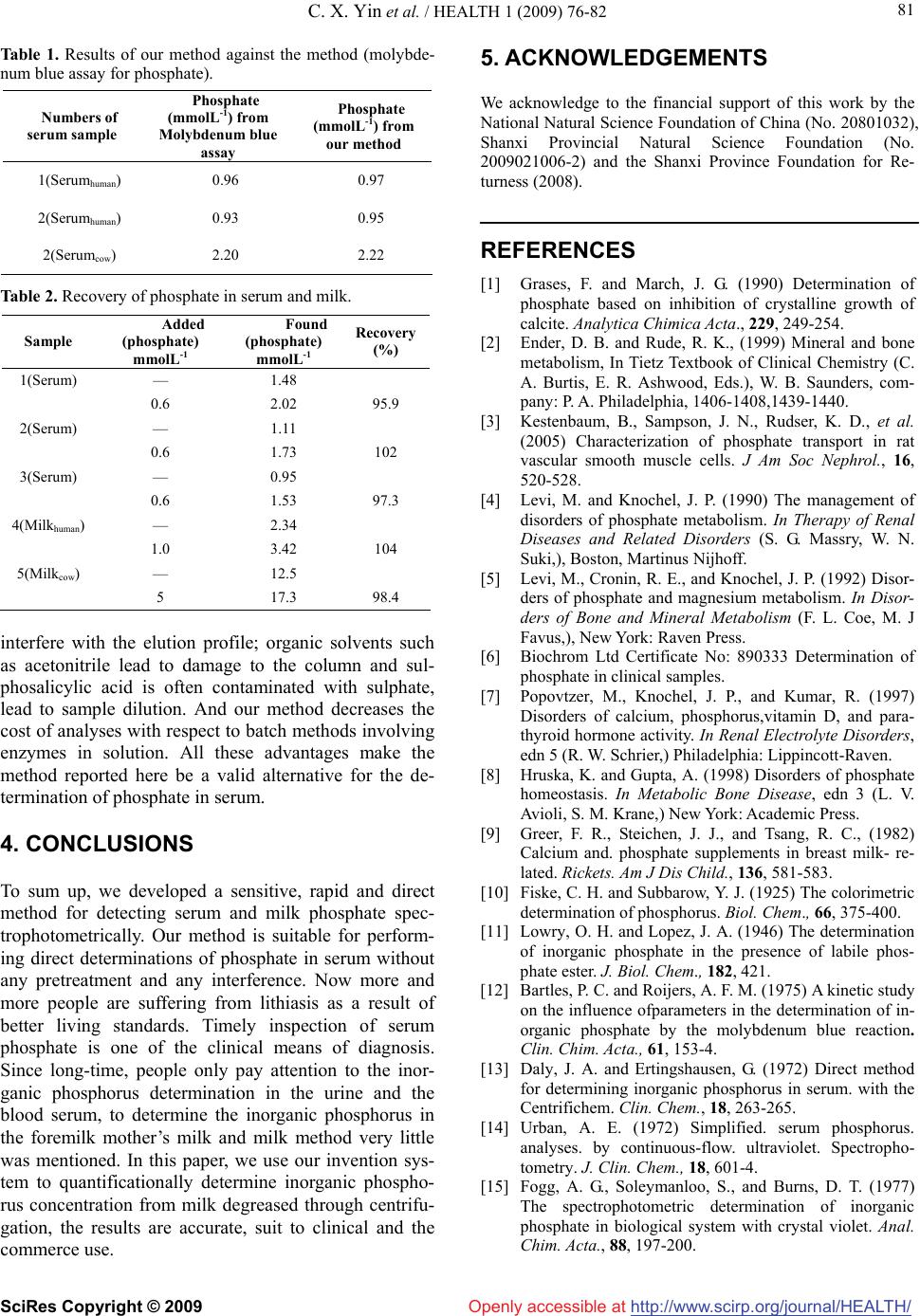
C. X. Yin et al. / HEALTH 1 (2009) 76-82
SciRes Copyright © 2009 http://www.scirp.org/journal/HEALTH/
81
Openly accessible at
Table 1. Results of our method against the method (molybde-
num blue assay for phosphate).
Numbers of
serum sample
Phosphate
(mmolL-1) from
Molybdenum blue
assay
Phosphate
(mmolL-1) from
our method
1(Serumhuman) 0.96 0.97
2(Serumhuman) 0.93 0.95
2(Serumcow) 2.20 2.22
Table 2. Recovery of phosphate in serum and milk.
interfere with the elution profile; organic solvents such
as acetonitrile lead to damage to the column and sul-
phosalicylic acid is often contaminated with sulphate,
lead to sample dilution. And our method decreases the
cost of analyses with respect to batch methods involving
enzymes in solution. All these advantages make the
method reported here be a valid alternative for the de-
termination of phosphate in serum.
4. CONCLUSIONS
To sum up, we developed a sensitive, rapid and direct
method for detecting serum and milk phosphate spec-
trophotometrically. Our method is suitable for perform-
ing direct determinations of phosphate in serum without
any pretreatment and any interference. Now more and
more people are suffering from lithiasis as a result of
better living standards. Timely inspection of serum
phosphate is one of the clinical means of diagnosis.
Since long-time, people only pay attention to the inor-
ganic phosphorus determination in the urine and the
blood serum, to determine the inorganic phosphorus in
the foremilk mother’s milk and milk method very little
was mentioned. In this paper, we use our invention sys-
tem to quantificationally determine inorganic phospho-
rus concentration from milk degreased through centrifu-
gation, the results are accurate, suit to clinical and the
commerce use.
5. ACKNOWLEDGEMENTS
We acknowledge to the financial support of this work by the
National Natural Science Foundation of China (No. 20801032),
Shanxi Provincial Natural Science Foundation (No.
2009021006-2) and the Shanxi Province Foundation for Re-
turness (2008).
REFERENCES
[1] Grases, F. and March, J. G. (1990) Determination of
phosphate based on inhibition of crystalline growth of
calcite. Analytica Chimica Acta., 229, 249-254.
[2] Ender, D. B. and Rude, R. K., (1999) Mineral and bone
metabolism, In Tietz Textbook of Clinical Chemistry (C.
A. Burtis, E. R. Ashwood, Eds.), W. B. Saunders, com-
pany: P. A. Philadelphia, 1406-1408,1439-1440.
[3] Kestenbaum, B., Sampson, J. N., Rudser, K. D., et al.
(2005) Characterization of phosphate transport in rat
vascular smooth muscle cells. J Am Soc Nephrol., 16,
520-528.
[4] Levi, M. and Knochel, J. P. (1990) The management of
disorders of phosphate metabolism. In Therapy of Renal
Diseases and Related Disorders (S. G. Massry, W. N.
Suki,), Boston, Martinus Nijhoff.
[5] Levi, M., Cronin, R. E., and Knochel, J. P. (1992) Disor-
ders of phosphate and magnesium metabolism. In Disor-
ders of Bone and Mineral Metabolism (F. L. Coe, M. J
Favus,), New York: Raven Press.
[6] Biochrom Ltd Certificate No: 890333 Determination of
phosphate in clinical samples.
[7] Popovtzer, M., Knochel, J. P., and Kumar, R. (1997)
Disorders of calcium, phosphorus,vitamin D, and para-
thyroid hormone activity. In Renal Electrolyte Disorders,
edn 5 (R. W. Schrier,) Philadelphia: Lippincott-Raven.
[8] Hruska, K. and Gupta, A. (1998) Disorders of phosphate
homeostasis. In Metabolic Bone Disease, edn 3 (L. V.
Avioli, S. M. Krane,) New York: Academic Press.
[9] Greer, F. R., Steichen, J. J., and Tsang, R. C., (1982)
Calcium and. phosphate supplements in breast milk- re-
lated. Rickets. Am J Dis Child., 136, 581-583.
[10] Fiske, C. H. and Subbarow, Y. J. (1925) The colorimetric
determination of phosphorus. Biol. Chem., 66, 375-400.
[11] Lowry, O. H. and Lopez, J. A. (1946) The determination
of inorganic phosphate in the presence of labile phos-
phate ester. J. Biol. Chem., 182, 421.
[12] Bartles, P. C. and Roijers, A. F. M. (1975) A kinetic study
on the influence ofparameters in the determination of in-
organic phosphate by the molybdenum blue reaction.
Clin. Chim. Acta., 61, 153-4.
[13] Daly, J. A. and Ertingshausen, G. (1972) Direct method
for determining inorganic phosphorus in serum. with the
Centrifichem. Clin. Chem., 18, 263-265.
[14] Urban, A. E. (1972) Simplified. serum phosphorus.
analyses. by continuous-flow. ultraviolet. Spectropho-
tometry. J. Clin. Chem., 18, 601-4.
[15] Fogg, A. G., Soleymanloo, S., and Burns, D. T. (1977)
The spectrophotometric determination of inorganic
phosphate in biological system with crystal violet. Anal.
Chim. Acta., 88, 197-200.
Sample
Added
(phosphate)
mmolL-1
Found
(phosphate)
mmolL-1
Recovery
(%)
1(Serum) — 1.48
0.6 2.02 95.9
2(Serum) — 1.11
0.6 1.73 102
3(Serum) — 0.95
0.6 1.53 97.3
4(Milkhuman) — 2.34
1.0 3.42 104
5(Milkcow) — 12.5
5 17.3 98.4